According to the norms of SNiP, the summer cottage is fenced off with a barrier, which provides for the presence of a gate or a wicket. They are trying to decorate the entrance group beautifully. It is not so difficult to do it with your own hands.
Material for the manufacture of wickets
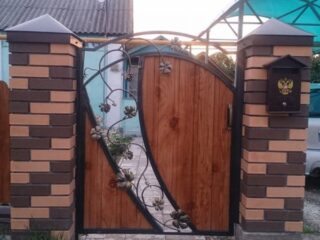
An entrance gate for a private house can be made of a variety of materials. The requirements are small: the sash should open easily, prevent the entry of animals, and serve as part of the allotment fence. High strength, heat saving, burglary resistance are not important here.
If the fence is light, the material for the sash can be used the same as for the fence: mesh-netting, euro shtaketnik, wooden boards, iron bars for the lattice. If the fence is stone or brick, the material is chosen in accordance with the design of the residential building. Usually the gate is deaf, but it can be decorated in an unusual way.
More often, the gate to the house is made of the following materials:
- Wooden boards or picket fence - the simplest cheap option, is a primitive frame of 3-4 boards and a picket filling. If the work is done carefully, such a gate is quite aesthetic.
- An interesting option is obtained if they take lining, terrace boards, modules from planks for cladding.
- Metal profile - more often it serves as a frame and is revetted with corrugated board, steel sheets, euro shtaketnik. The model is more practical than beautiful.
- Lattice - rarely made independently, but very effective. Very graceful models with forging - overhead forged or cast elements.
- Combined - combine materials for both beauty and practicality. For example, boards assembled in a metal frame will last much longer. The wicket wicket door with polycarbonate filling is exceptionally beautiful.
The easiest way is to decorate a wooden gate. The material is easy to process and cut. The service life of carved wooden doors is no less than deaf ones.
Fence gate decor

A gate for a private house can be modified using different finishing methods. Not all of them can be made by hand.
Glass inserts
An extremely refined way of decoration. Option 2:
- A wooden sash with an insert made of glass or polycarbonate - this model resembles an interior door, but is more durable.
- An interesting option is a wrought-iron gate with elements of an iron frame and inserts of colorless or colored glass. The model is expensive and surprisingly beautiful.
For finishing the street sash, impact-resistant glass or polycarbonate is used.
Antique door
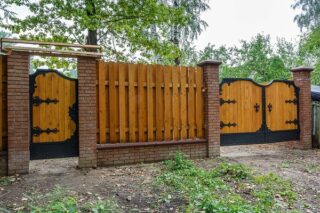
The design of the gate in the country house in the form of an old door is interesting. Not only the finishing method is reproduced - through carving, forging, but also stylistic motives. The options are different:
- Heavy sash made of aged wood with deliberately rough forged fittings. This is how the doors in a rich house looked in the Middle Ages.
- Arched sash in a regular opening with through carvings in the Renaissance or Baroque style. If the wood is sanded and varnished, such a gate is combined with a heavy stone "palace" fence. If the tree is "aged", the whole estate takes on a shade of antiquity.
- Smooth wood paneling with sculptural wrought-iron details, such as a doorbell shaped like a knocker and a lion's head.
It is important to achieve similarity to the door, and not just to design a wicket.
Forged patterns
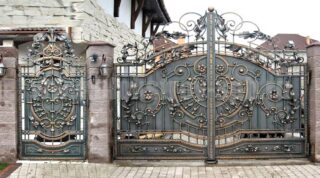
A modern beautiful wicket is made in a variety of styles. Most often, a lattice serves as the basis, against the "background" of which a pattern of overhead forged parts is created. This option can be assembled on your own by fixing the finished jewelry on the lattice according to the drawing.
But they also make complex models. An openwork canvas with a complex ornament or even an image is forged in its entirety and represents a complete composition. Usually this is a themed design, for example, a gate in the form of a lawn with tulips or a rose bush. Geometric patterns are less common, but plant patterns are always in place.
The forged model can also be given a touch of antiquity. For this, the finished product is treated with special solutions. In this case, the metal is partially oxidized and changes color.
Plant motives
For a summer cottage, plant motifs are more suitable than heraldic or geometric ones. There are many options:
- images of flowers - carved on wood or in the form of a forged ornament;
- vegetable crops - a luxurious head of cabbage, for example, a strawberry bush;
- effective options with the image of a tree, while the wicket can reach a great height;
- floral pattern - an ornament that includes flowers, leaves, bouquets.
The lattice of the gate can become the basis for a green climbing plant.
Web
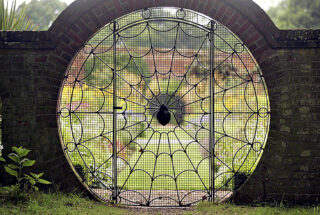
The original version of the forged sash is in the form of a spider web with a spider in the center or on the side. This "transparent" structure looks very good in combination with a brick fence.
Arch
The easiest way to give originality to the entrance group is to change the shape of the canvas and frame. It is not so difficult to make an arch from wood, metal, to assemble an arch from brick. But at the same time, the entrance looks impressive and elegant.
Built-in or free-standing wicket
To choose options for gates for the fence, you need to evaluate its placement: built-in or free-standing.
Built-in saves space, time and material. On the other hand, this option is strictly limited in size by the dimensions of the doors. At the bottom of the obligatory there is a sill that should be crossed. In addition, the wicket disrupts the weight balance of the door, which leads to rapid wear.
The stand-alone model does not have such disadvantages. But you need to spend more time on its arrangement. For her, you need to make your own opening, weld the frame, install it. But the design is not limited by anything.
Installation and installation of the frame of the wicket
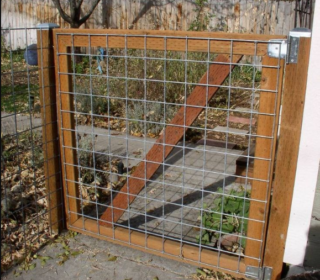
Beautiful or simple wickets made of metal, wood, polycarbonate are assembled on a frame. The easiest way is to make a wooden frame for the model from a mesh or picket fence.
- For the frame, a bar with a section of 40 * 40 mm is taken and sawn to size.
- Places of cuts are polished. On a flat surface, a frame is assembled from bars. Fasten the wood with iron staples or nails.
- To strengthen the structure, the frame is connected with a diagonal crossbar.
- Planks, picket fence, boards, mesh, profiled sheet, and other material are stuffed onto the frame. Install fittings.
- After assembly, start finishing.
A beautiful gate offers both original and classic design. It's all about the harmony of the composition and compliance with the style of the building.








